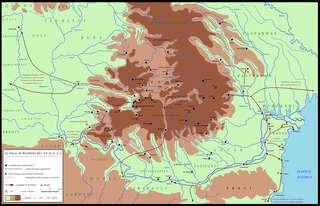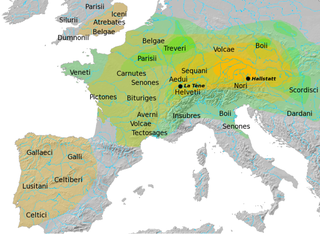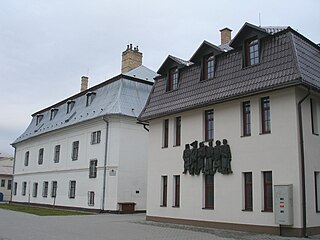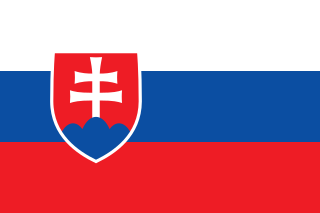
The Celts are an Indo-European ethnolinguistic group of Europe identified by their use of Celtic languages and cultural similarities. The history of pre-Celtic Europe and the exact relationship between ethnic, linguistic and cultural factors in the Celtic world remains uncertain and controversial. The exact geographic spread of the ancient Celts is disputed; in particular, the ways in which the Iron Age inhabitants of Great Britain and Ireland should be regarded as Celts have become a subject of controversy. According to one theory, the common root of the Celtic languages, the Proto-Celtic language, arose in the Late Bronze Age Urnfield culture of Central Europe, which flourished from around 1200 BC.
This article discusses the history of the territory of Slovakia.

The Dacians were a Thracian people who were the ancient inhabitants of the cultural region of Dacia, located in the area near the Carpathian Mountains and west of the Black Sea. This area includes the present-day countries of Romania and Moldova, as well as parts of Ukraine, Eastern Serbia, Northern Bulgaria, Slovakia, Hungary and Southern Poland. The Dacians spoke the Dacian language, a sub-group of Thracian, but were somewhat culturally influenced by the neighbouring Scythians and by the Celtic invaders of the 4th century BC.

Burebista was a Thracian king of the Getae and Dacian tribes from 82/61 BC to 45/44 BC. He was the first king who successfully unified the tribes of the Dacian Kingdom, which comprised the area located between the Danube, Tisza, and Dniester rivers and modern day Romania. In the 7th and 6th centuries BC it became home to the Thracian peoples, including the Getae and the Dacians. From the 4th century to the middle of the 2nd century BC the Dacian peoples were influenced by La Tène Celts who brought new technologies with them into Dacia. Sometime in the 2nd century BC the Dacians expelled the Celts from their lands. Dacians often warred with neighbouring tribes, but the relative isolation of the Dacian peoples in the Carpathian Mountains allowed them to survive and even to thrive. By the 1st century BC the Dacians had become the dominant tribe.

Dacian is an extinct Indo-European language that was spoken in the Carpathian region in antiquity. In the 1st century, it was probably the predominant language of the ancient regions of Dacia and Moesia and possibly of some surrounding regions. The language was probably extinct by the 7th century AD.
This article spans the known pre-history and early history of the territory of the historical Hungary up to the Magyar (Hungarian) conquest in the 9th century and the foundation of the Principality of Hungary. For the prehistory of the Magyar tribes before they came to the Carpathian Basin, see Hungarian prehistory.

The so-called Free Dacians is the name given by some modern historians to those Dacians who putatively remained outside, or emigrated from, the Roman Empire after the emperor Trajan's Dacian Wars. Dio Cassius named them Dakoi prosoroi meaning "neighbouring Dacians".

The prehistory and protohistory of Poland can be traced from the first appearance of Homo species on the territory of modern-day Poland, to the establishment of the Polish state in the 10th century AD, a span of roughly 500,000 years.

The Costoboci were an ancient people located, during the Roman imperial era, between the Carpathian Mountains and the river Dniester. During the Marcomannic Wars the Costoboci invaded the Roman empire in AD 170 or 171, pillaging its Balkan provinces as far as central Greece, until they were driven out by the Romans. Shortly afterwards, the Costoboci's territory was invaded and occupied by Vandal Hasdingi and the Costoboci disappeared from surviving historical sources, except for a mention by the late Roman Ammianus Marcellinus, writing around AD 400.

Mojmir I, Moimir I or Moymir I was the first known ruler of the Moravian Slavs (820s/830s–846) and eponym of the House of Mojmir. In modern scholarship, the creation of the early medieval state known as Great Moravia is attributed either to his or to his successors' expansionist policy. He was deposed in 846 by Louis the German, king of East Francia.

Havránok is an important archaeological site in northern Slovakia. It is on a hill above the Liptovská Mara water reservoir around 2 km (1.2 mi) from the village of Bobrovník, about halfway between Ružomberok and Liptovský Mikuláš in the Liptov region. The archaeologists unearthed a prehistoric Celtic hill fort and a medieval wooden castle in the 1960s, during the construction of the Liptovská Mara dam. Both objects have been partially reconstructed. During the Iron Age and the Roman Era, the shrine of Havránok was an important religious center of the Celts living in Slovakia.

Poland in antiquity is characterized by peoples belonging to numerous archeological cultures living in and migrating through various parts of the territory that now constitutes Poland in an era that dates from about 400 BC to 450–500 AD. These people are identified as Slavic, Celtic, Germanic, Baltic, Thracian, Avar, and Scythian tribes. Other groups, difficult to identify, were most likely also present, as ethnic composition of archeological cultures is often poorly recognized. While lacking use of a written language to any appreciable degree, many of them developed relatively advanced material culture and social organization, as evidenced by the archeological record, for example judged by the presence of richly furnished, dynastic "princely" graves. Characteristic of the period was high geographical migration rate of large groups of people, even equivalents of today's nations. This article covers the continuation of the Iron Age (see Bronze and Iron Age Poland), the La Tène and Roman influence and Migration periods. La Tène period is subdivided into La Tène A, 450 to 400 BC; La Tène B, 400 to 250 BC; La Tène C, 250 to 150 BC; La Tène D, 150 to 0 BC. 400 to 200 BC is also considered the early pre-Roman period and 200 to 0 BC the younger pre-Roman period (A). It was followed by the period of Roman influence, of which the early stage had lasted from 0 to 150 AD (0–80 B1, 80–150 B2), and the late stage from 150 to 375 AD (150–250 C1, 250–300 C2, 300–375 C3). 375 to 500 AD constituted the (pre-Slavic) Migration Period (D and E).

The Anartes a.k.a. Anarti, Anartii or Anartoi were Celtic tribes, or, in the case of those sub-groups of Anartes which penetrated the ancient region of Dacia, Celts culturally assimilated by the Dacians.

Lipitsa culture is the archaeological material culture supposedly representative of a Dacian tribe. It took its name from the Ukrainian village of Verkhnya Lypytsya, Rohatyn Raion, Ivano-Frankivsk Oblast.

Teurisci was a Dacian tribe at the time of Ptolemy. They are considered originally Celts, a branch of the Celtic Taurisci (Noricum), who moved to Upper Tisza. However, the archaeology shows that Celts have been absorbed by Dacians, at some extent both creating a Celto-Dacian cultural horizon in the upper Tisza.

The appearance of Celts in Transylvania can be traced to the later La Tène period . Excavation of the great La Tène necropolis at Apahida, Cluj County, by S. Kovacs at the turn of the 20th century revealed the first evidence of Celtic culture in Romania. The 3rd–2nd century BC site is remarkable for its cremation burials and chiefly wheel-made funeral vessels.
The area today known as Slovakia has been inhabited throughout the prehistoric period.

The Martin Declaration is the name usually given to the Declaration of the Slovak Nation that was proclaimed in the town of Turčiansky Svätý Martin on 30 October 1918. The declaration was effectively a declaration of independence from the Kingdom of Hungary and presaged Slovakia's unification with the Czech lands as part of the new state of Czechoslovakia.
The Demands of the Slovak Nation was a manifesto issued by Slovak nationalists during the revolutions of 1848 in the Habsburg areas. It was prompted by the nationalists' realisation that the Hungarian government would not heed the calls of Ľudovít Štúr for the establishment of public regional assemblies and the acceptance of a Slovak petition at a national assembly.














